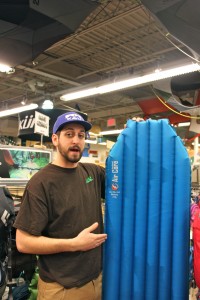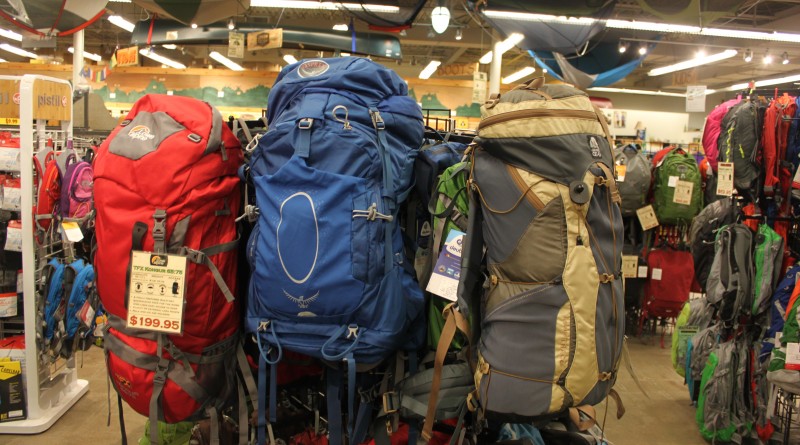Packing List: Vermont Sports shows you what to pack for the Long Trail

With its 273-mile trail, 175 miles of side trails, and nearly 70 shelters, the Vermont Long Trail offers hiking opportunities for the day hiker, weekend overnighter, and extended backpacker. If an overnight or weeklong trip on the trail is on your spring and summer checklist, it helps to carefully consider what to bring with you.
Packing the right gear, however, is easier said than done. To make it easier, Vermont Sports sought out Nick Irvine, gear specialists at Outdoor Gear Exchange in Burlington for some advice. Irvine, who came to Vermont for college, but stayed around for the outdoors, has been outfitting customers for six years and has completed portions of the Long Trail.
“When I graduated, I wanted to live in a place that inspired me to get outside,” he says. “I also wanted a job that helped others do the same. This job allows me to do both.”
Here are some of Nick’s suggestions:
Boots:
What to look for: When looking for a boot, find a full-grain leather boot that will give you stability under a heavy pack. “Fit is the most important thing,” says Irvine. “Sliding forward or backward in your boot when going up or down a hill is a sure sign that you should not be in those boots.” Care for them by cleaning and sealing the leather with waterproofing. Before heading out, get a feel for them by wearing them around your house.
Mammut Pacific Crest: This is mid-height leather boot with a waterproof Gore Tex lining and an aggressive rubber sole. Featuring a variety of technical features (lateral support, feet cushioning and temperature regulation) in a low-profile package, this boot is a good fit for the hiker who prefers a stiffer boot on either day hikes or extended trips. $249
Lowa Renegade: This is a softer, full leather boot with Gore Tex lining ideal for weekend trips. Its lighter weight makes it more agile than stiffer boots. $219
Aku Tribute: The Tribute is an Italian-made, medium-stiff boot made of full leather. It has a no-frills design with minimal stitching and aggressive traction for an excellent entry-level backcountry boot. $139
Clothes:
What to look for: While your cotton sweatshirts may be warm now, they’ll be completely useless when wet. As an alternative, look for synthetic blends of polyester or wool that will wick moisture from your skin and keep you comfortable. Your clothes should also be lightweight and dry quickly. The added bonus of the wool option is it won’t stink after you’re worn it a few days. “It’s definitely an added bonus if you’re a single guy on the trail,” advises Irvine.
Rab Aeon Tee: The Aeon is polyester blend with added UPF protection. $35.
Icebreaker Tech Tee: This Tee shirt is made of Merino wool with high warmth to weight ratio, giving you good insulating properties at a low weight. $69
Rain jackets/shells:
What to look for: Your waterproof shell will protect you from the elements. Find a jacket that can collapse into a small size that you can wear with an insulating layer like a fleece underneath. Also remember: The higher the quality of waterproofing, the better the breathability.
Marmot PreCip: A reliable two-layer rain jacket with all the basics, including zippered pockets, hood and fully-taped seams. $100
Outdoor Research Helium: The Helium is a notable pick for its complete weatherproofing while saving weight and space. Weighing just 5.5 ounces, it stuffs into a tiny stuff sack. $150
Backpacks:
What to look for: Like your boots, this is one piece of gear that you’ll become very familiar with, so pick wisely. A good pack should fit everything and tidily organize your gear while still giving you easy access. While external frame packs may have a classic look, Irvine says the better choice for most is the internal frame pack. “The frame backpacks are just not as comfortable and not as light,” he says.
Lowe Alpine TFX Kongur: With its adjustable torso length, the Kongur is a good pack to share or even makes a good hand-me-down. This pack is fully loaded with features like hydration system compatibility, internal rain cover and a separate compartment for your sleeping bag. Zippers on all sides allow you to easily access gear from the top, middle and bottom. Weight: Four pounds, ten ounces. $200
Osprey Atmos: Good for those folks looking to pack light and move fast while staying cool. The Atmos has zippered pockets on all sides, plus multiple lash-points for sleeping pads or other gear and a comfortable mesh on the back to keep you cool and dry while you move. Weight: 3 pounds, nine ounces. $250
Granite Gear Nimbus Trace: This fully modifiable pack has shoulder and hip straps that can be reattached to different points for a custom fit. From a simple overnight to a full week in the woods, this is one pack that can do it all. Weight: Four pounds. $290
Sleeping pads:
What to look for: While you can’t bring your mattress with you, a collapsible pad can make for a comfortable rest after a day on the trail. Your best bets are either foam or inflatable options. While inflatable kinds may be more comfortable, their comfort comes at a cost to durability.
Therm-a-Rest Z-Lite: The Z Lite is a three-season pad with a reflective layer on one side for added warmth retention. $35
Climate Static V: This middle-of-the-road pad combines comfort with compactness, thanks to a design that displaces air evenly under your body. $65
Big Agnes Air Core: While this is an insulated pad, you may find yourself using it year round for its comfort and compactness. As an added bonus, its mummy shape makes it compatible with some varieties of sleeping bags, which have a pocket insert to keep your pad under you. $100
Sleeping bags
What to look for: In warmer months, you won’t need to worry about bigger, bulkier bags. A summer weight bag can collapse to the size of a water bottle and will keep you comfortable in mild evenings. Look for a bag with a comfort rating in 40 to 45 degree range. Sleeping bags are insulated with either down or synthetic fill. While down will be more insulating, it loses its warmth when wet. Synthetic bags won’t pack down as much, but will still be reliable in wet weather.
Lafuma Lightway 45: The Lightway is an extremely light and compactable bag for fast-moving trips in warmer weather. This bag is filled with 600-fill duck down protected by a water-resistant treatment to bead condensation off the shell. $100
Big Agnes Cross Mountain 45: This bag features a stuff-pocket where you can fit a sweater or some clothes to make a pillow. Its square shape gives it a roomier fit, while a pocket underneath with keep your sleeping pad in place. $149
Mountain Hardware Ratio: This lightweight bag is treated to be extremely durable and water resistant. The 650-fill down is treated with a special sealant called Q-Shield to keep down from losing its insulting properties on damper nights. $219
Stoves:
What to look for: In the backcountry, cooking over an open fire is usually not an option. As an alternative, lightweight, packable stoves allow you to boil water and cook meals at a relatively low cost. Find a model that’s lightweight and fuel-efficient. “Some stoves will be good for boiling water quickly,” says Irvine. “If you plan on cooking more, find a model that lets you adjust the size of the flame from simmer to full-blast.”
MSR Pocket Rocket: The compact Pocket Rocket is a canister stove needing no assembling or priming. Simply screw on the canister of propane or butane and light it up. The downside? Canisters are not refillable. $40
MSR Whisperlite Universal: This stove can burn any kind of combustible fuel – propane, butane, diesel or even moonshine will all work, but be aware that the variety of fuels that can be used means that you’ll need to clean it more. $140
MSR Reactor: Don’t let the small size of the Reactor fool you. This stove can boil a liter of water in a just over three minutes. When you’re done, the fuel canister and stove both store inside the pot it comes with. $169
Tents:
What to look for: Your tent will be your home away from home, so find something roomy, lightweight and watertight that packs away small and can be set up easily and quickly.
Eureka Apex II: For campers on a budget, this is a good choice for sleeping on the trail as well as in your backyard. The Apex features a standalone design with a waterproof bathtub floor and rainfly and no-see-um mesh to keep bugs out and air flowing. It’s heavy at 7 pounds, 3 ounces. $130
Sierra Designs Lightning HT 2: The Lightning HT 2 strikes a solid compromise between weight and livability. At 4 pounds, 4 ounces, this model has two doors and two vestibules, $200
MSR Hubba Hubba: The Hubba Hubba has an easily pitched hub and pole set-up that can be configured in three different ways. Weighing just 4 pounds, it also features two full-size doors and vestibules to store gear. It packs down small and sets up fast, thanks to its unique single pole design. $389

